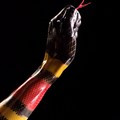Moving Image Department #9: Desire in Language
National Gallery in Prague - Trade Fair Palace (Veletržní palác), Dukelských hrdinů 47, Prague 7
October 24, 2018 - February 3, 2019
|
Moving Image Department #9: Desire in LanguageNational Gallery in Prague - Trade Fair Palace (Veletržní palác), Dukelských hrdinů 47, Prague 7October 24, 2018 - February 3, 2019
https://www.ngprague.cz/en/exposition-detail/moving-image-department-9-desire-in-language/ Curator: Adam Budak The 9th chapter of the Moving Image Department is a “conversation piece” per se in which the protagonists/the artists explore the landscape of the language: its performativity and the limits of articulation. Both, Czech artist Roman Štětina and Croatian artist, Damir Očko investigate the language’s behavior, its patterns of acting and an ability to evoke an action. They embark on a search for a new vocabulary to reflect the politics and its gestural economy as well as to decode the structures of desire through the means of poetry and its revolutionary power; theirs is a venture into the possibility of the political and the affective hidden within a poetic gesture, often leaving the protagonist on the edge of a physical and mental exhaustion. The performative self, conditioned by the language and the act of speech, and its struggle with the articulation, occupy the centre-stage of Štětina’s and Očko’s theatricalized and self-referential cinematic works. Roman Štětina’s feature-length film, Instructions for Use of Jiří Kolář (2015), made in collaboration with Miroslav Buriánek—a long standing director of radio drama for Czech Radio—documents the process of recording a series of poems by the Czech poet, artist and translator Jiří Kolář (1914-2002). Buriánek’s interpretation of Kolář’s poems, Instructions for Use (1969) is filmed over the course of an arduous two-day recording rehearsal; translating them from the page through a precise and dynamic process, refining intonation, intensity and silences to convey Kolář’s meaning and Buriánek’s interpretation of it. Instructions for Use occupy a liminal zone between poetry and what might be called ‘action art’. Kolář’s poems suggest actions that were absurd or even impossible within the political reality of the time and place in which they were written, and could only exist in the imagination. Within a repressive and censorious political system, the freedom of thought implicit in these poems was a strong declaration. Offering a definition of today’s language as an act of resistance, Damir Očko’s work is an attempt at emancipation, formulated in words and images. His recent cinematic diptych Dicta borrows its title from the plural of ‘dictum’, coming from the Latin, meaning an undisputed, authoritative truth. Following Dicta I, based on the autobiographical writings of Bertolt Brecht’s Telling the Truth: 5 Difficulties (1934), written when the latter fled the German regime, Dicta II is built around a series of “safewords” (code words, collected from various public forums, signaling a boundary not to be crossed), recited by a voice-over in an non-affective way to the visual accompaniment of a semi-violent martial arts fight. Influenced by Dadaism and conceptual art, the film takes the form of a collage and regroups an ensemble of inaudible and contradictory statements, as obscure as the images, thus evoking epic theatre and Brechtian distancing which awakens the viewer’s political and critical consciousness. Roman Štětina (b. Kadaň, 1986) currently lives and works in Prague. Štětina graduated from the Academy of Fine Arts in Prague in 2015 after spending two years on the Städelschule in Frankfurt am Main studying under Judith Hopf and Douglas Gordon. He is one of the youngest recipients of Jindrich Chalupecky Award (2015). Štětina had been included in Manifesta 11, Zurich curated by Christian Jankowski (2016). Recent solo exhibitions include: Instructions for Use of Jiří Kolář (with Miroslav Buriánek), Spike Island, Bristol; Shave and a haircut – two bits, Cardiff Contemporary, Cardiff; The Fortress of Solitude From the Holy Wood of Eternal Noise, MNAC Bucharest, curated by Anca V. Mihulet and Diana Marincu (all 2016); Souvenir, Polansky Gallery, Prague; Lecture, Gallery of Fine Arts, Zlín (CZ) (both 2015); Mluv, abych tě viděl, Kabinet Gallery, TIC, Brno (CZ) (2014). Recent group exhibitions include: Medium: Figure, Prague City Gallery (2017); All Watched Over, James Cohan Gallery; Silver Lining, National Gallery in Prague; Graduates of the Academy of Fine Arts in Prague, National Gallery in Prague; 7th Zlín Youth Salon, Gallery of Fine Arts, Zlín (CZ); The Importance of Being a (Moving) Image, National Gallery in Prague; Jindrich Chalupecky Award, National Gallery in Prague (all 2015); Straight to Camera: Performance for Film, Modern Art Oxford, Peripheral Vision, IV. Moscow International Biennale for Young Art, MMOMA; Explain Me Not, Autocenter, Berlin (all 2014). Miroslav Buriánek (b. 1951) is one of Czech Republic’s leading radio directors. After graduating as a theatre director from the Theatre Faculty of the Academy of Performing Arts in Prague (DAMU), he worked for Czech Radio in Pilsen from 1978 until 2015, creating thousands of reports, radio documentaries and radio dramas. Damir Očko was born in 1977 in Zagreb, where he lives and works. A graduate from the Academy of Fine Arts in Zagreb, he creates video works, photography, installations and objects including sound, poetry as well as works on paper—photo-collages and scores. Očko has represented Croatia at the 56th Venice Biennale (2015), and has exhibited, among others, at the Palais de Tokyo in Paris, the Museum of Contemporary Art in Zagreb, Künstlerhaus Halle für Kunst und Medien in Graz and the Centre for Contemporary Art Zamek Ujazdowski in Warsaw. His most recent solo exhibitions include Dicta at Jeu de Paume, Paris, Dicta at CAPC Museum of Contemporary Art in Bordeaux, Damir Očko at the Agency Gallery, London, Repeat After Me at Eastwards Prospectus in Bucharest and Year Out of Shape at Tiziana di Caro, Naples. Damir Očko’s works can be found in the collections of Louis Vuitton Foundation for Creation and CNAP – Centre national des arts plastiques in Paris and at the MUDAM in Luxembourg.
National Gallery in Prague - Trade Fair Palace (Veletržní palác) |


